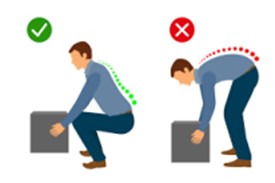A nurse is teaching a client who has strained her back muscles while preparing to move to a new apartment. Which of the following instructions should the nurse include?

Twist at the waist when she moves an object to one side.
Relax Her abdominal muscles when she lifts an object.
Bend at the knees when picking up an object.
Hold an object away from her body as she lifts it.
The Correct Answer is C
A. Twisting at the waist while lifting or moving an object can strain the back muscles and potentially lead to injury. The nurse should advise against this.
B. Relaxing the abdominal muscles while lifting an object can lead to inadequate support for the spine, potentially causing further strain or injury. The nurse should instruct the client to engage the abdominal muscles for stability.
C. Correct. Bending at the knees when picking up an object helps distribute the weight more evenly and reduces strain on the back muscles. This is a safe and recommended technique for lifting.
D. Holding an object away from the body while lifting it can increase the strain on the back muscles. The client should be advised to keep the object close to their body for better support and balance.
Nursing Test Bank
Naxlex Comprehensive Predictor Exams
Related Questions
Correct Answer is A
Explanation
A. Holding the wrist at a 90-degree flexion is known as Phalen's maneuver, which is a test for carpal tunnel syndrome. This position puts pressure on the median nerve, potentially reproducing the client's symptoms.
B. Flexing the right arm at the elbow is not a specific test for carpal tunnel syndrome.
C. Holding the right arm straight is not a specific test for carpal tunnel syndrome.
D. Extending the right arm upward is not a specific test for carpal tunnel syndrome.
Correct Answer is C
Explanation
A. Placing weight on the heels when moving an object can lead to an improper body mechanic. The client should shift their weight onto the balls of their feet for better stability.
B. Standing with feet close together when lifting an object can also lead to improper body mechanics. The client should maintain a wide base of support by keeping their feet shoulder-width apart.
C. Facing the direction of movement when sliding an object across the floor is an example of proper body mechanics. It helps ensure that the client uses their body weight and strength efficiently.
D. Moving the front foot backward when pushing an object can help maintain balance and provide better leverage, which is a correct body mechanics technique. However, the question specifically asks about sliding an object across the floor, not pushing.
Whether you are a student looking to ace your exams or a practicing nurse seeking to enhance your expertise , our nursing education contents will empower you with the confidence and competence to make a difference in the lives of patients and become a respected leader in the healthcare field.
Visit Naxlex, invest in your future and unlock endless possibilities with our unparalleled nursing education contents today
Report Wrong Answer on the Current Question
Do you disagree with the answer? If yes, what is your expected answer? Explain.
Kindly be descriptive with the issue you are facing.
